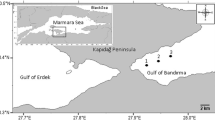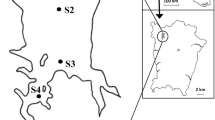Abstract
Zooplankton collected from vertical net tows were related to the environmental variables from 98 lakes from the Interior Plateau of British Columbia. Canonical correspondence analysis showed that both salinity and ionic composition (pH and Mg) of the lake-water made major and significant contributions to the first two ordination axes (λ=0.42 and 0.11 respectively,P<0.05). BothArtemia franciscana andMoina hutchinsoni had their highest relative abundance in meso-hypersaline waters. However,Artemia franciscana preferred waters that were higher in Mg and Ca, whileMoina hutchinsoni was found in waters that were lower in Mg and Ca. Similarly, at intermediate salinities,Daphnia pulex and the calanoid copepods preferred waters slightly lower in Mg and Ca, whereasCeriodaphnia laticaudata andSimocephalus spp. were relatively more common in waters higher in Mg and Ca. Because the freshest lakes studied varied much less in ionic composition, the zooplankton in these lakes did not show a preference to ionic composition. As expected, multi-generic groups, such as the calanoid copepods, cyclopoid copepods and nauplii, had wider tolerances to conductivity than groups identified to lower taxonomic levels. Significant weighted-averaging regression and calibration models of conductivity were developed based on zooplankton species composition from the study lakes (r 2=0.56,P<0.05). Samples composed largely of multi-generic taxa yielded the worst estimates of salinity in the reconstruction model. This study suggests that zooplankton community composition may be developed into a useful proxy for paleosalinity reconstruction.
Similar content being viewed by others
References
Cumming, B.F. and Smol, J.P. 1993. Development of diatom-based salinity models for paleoclimatic research from lakes in British Columbia (Canada). Hydrobiologia 269/270: 179–196.
Cumming, B.F., Wilson, S.E., Hall, R.I. and Smol, J.P. 1995. Diatoms from British Columbia (Canada) lakes and their relationship to salinity, nutrients, and other limnological variables. Bibliotheca Diatomologica 31: 1–207.
De Deckker, P. and Forester, R.M. 1988. The use of Ostracods to reconstruct continental paleoenvironmental records. In: P. De Deckker, J.P. Colin and J.P. Peypouquet (Eds) Ostracoda in the Earth Sciences, pp. 175–199. Elsevier, New York.
Frey, D.G. 1964. Remains of animals in Quaternary lake and bog sediments and their interpretation. Archiv für Hydrobiologie 2: 1–114.
Frey, D.G. 1993. The penetration of Cladocera into saline waters. Hydrobiologia 267: 233–248.
Hammer, U.T. 1986. Saline Lake Ecosystems of the World. Dr W. Junk Publishers, Boston, 616 pp.
Hammer, U.T. 1993. Zooplankton distribution and abundance in saline lakes of Alberta and Saskatchewan, Canada. International Journal of Salt Lake Research 2: 111–132.
Hammer, U.T. and Forró, L. 1992. Zooplankton distribution and abundance in saline lakes of British Columbia, Canada. International Journal of Salt Lake Research 1: 65–80.
Jeffery, D.A. 1989. Laboratory Quality Assurance Manual. Zenon Environmental Inc., Burnaby, BC, Canada, 34 pp.
Juggins, S. and ter Braak, C.J.F. 1993. CALIBRATE — Unpublished computer program, Environmental Change Research Centre, University College, London.
Line, J.M., ter Braak, C.J.F. and Birks, H.J.B. 1994. WACALIB version 3.3 — a computer program to reconstruct environmental variables from fossil assemblages by weighted averaging and to derive sample-specific errors of prediction. Journal of Paleolimnology 10: 147–152.
Moore, J.E. 1952. The Entomostraca of southern Saskatchewan. Canadian Journal of Zoology 30: 410–450.
Pennak, R.W. 1989. Fresh-Water Invertebrates of the United States: Protozoa to Mollusca, pp. 369–409. John Wiley and Sons, Inc., Toronto.
Pinel-Alloul, B., Niyonsenga, T. and Legendre, P. 1995. Spatial and environmental components of freshwater zooplankton structure. Ecoscience 2: 1–19.
Renaut, R.W. 1990. Recent carbonate sedimentation and brine evolution in the saline lake basins of the Cariboo Plateau, British Columbia, Canada. Hydrobiologia 197: 67–81.
Reynolds, J.D. 1979. Crustacean Zooplankton of some saline lakes in central British Columbia. Syesis 12: 169–173.
Scudder, G.G.E. 1969. The fauna of saline lakes on the Fraser Plateau of British Columbia. Verhandlungen Internationale Vereiningung für Theoretische und Angewandte Limnologie 17: 430–439.
Shi, G.R. 1993. Multivariate data analysis in palaeoecology and palaeobiogeography — a review. Palaeogeography, Palaeoclimatology, Palaeoecology 105: 199–234.
Synerholm, C.C. 1979. The chydorid Cladocera from surface lake sediments in Minnesota and North Dakota. Archiv für Hydrobiologie 86: 137–151.
ter Braak, C.J.F. 1988. CANOCO — a FORTRAN program for canonical community ordination by [partial] [detrended] [canonical] correspondence analysis, principal components analysis, redundancy analysis (version 2.1). Technical Report LWA-88-02. Agricultural Mathematics Group, The Netherlands, Wageningen, 95 pp.
ter Braak, C.J.F. 1990. Update Notes: CANOCO version 3.10. Agricultural Mathematics Group, Wageningen, The Netherlands, 35 pp.
Tessier, A.J., and Horwitz, R.J. 1990. Influence of water chemistry on size structure of zooplankton assemblages. Canadian Journal of Fisheries and Aquatic Sciences 47: 1937–1943.
Thorp, J.H. and Covich, A.P. (Eds) 1991. Ecology and Classification of North American Freshwater Invertebrates, pp. 723–786. Academic Press, San Diego, CA.
Topping, M.S. and Scudder, G.G.E. 1977. Some physical and chemical features of saline lakes in central British Columbia. Syesis 10: 145–166.
Wilson, S.E., Cumming, B.F. and Smol, J.P. 1994. Diatom-salinity relationships in 111 lakes from the Interior Plateau of British Columbia, Canada: The development of diatom-based models for paleosalinity reconstructions. Journal of Paleolimnology 12: 197–221.
Williams, W.D., Boulton, A.J. and Taaffe, R.G. 1990. Salinity as a determinant of salt lake fauna: A question of scale. Hydrobiologia 197: 257–266.
Zeeb, B.A. and Smol, J.P. 1995. A weighted-averaging regression and calibration model for inferring lakewater salinity using chrysophycean stomatocysts from western Canadian lakes. International Journal of Salt Lake Research 4: 1–23.
Author information
Authors and Affiliations
Rights and permissions
About this article
Cite this article
Bos, D.G., Cumming, B.F., Watters, C.E. et al. The relationship between zooplankton, conductivity and lake-water ionic composition in 111 lakes from the Interior Plateau of British Columbia, Canada. International Journal of Salt Lake Research 5, 1–15 (1996). https://doi.org/10.1007/BF01996032
Issue Date:
DOI: https://doi.org/10.1007/BF01996032




